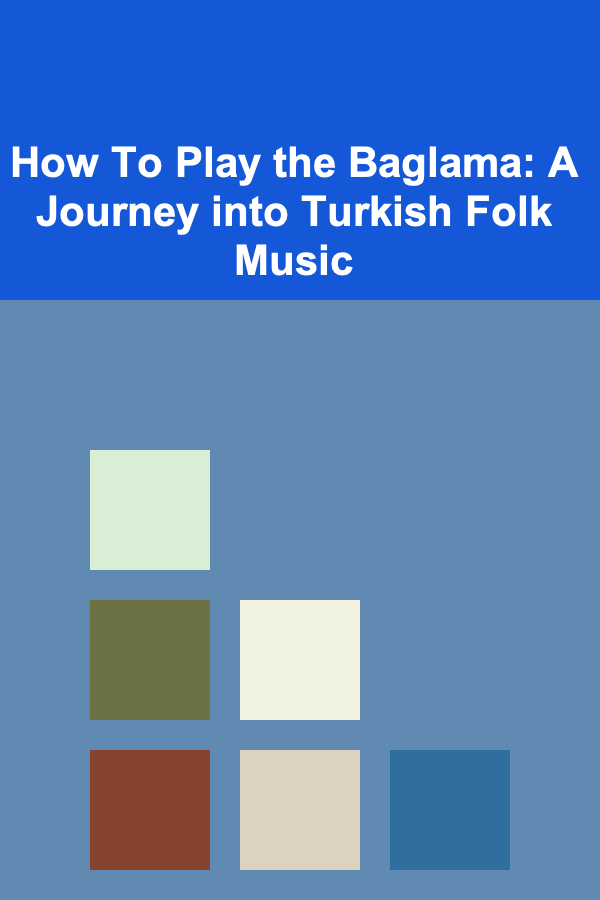
How To Play the Baglama: A Journey into Turkish Folk Music
ebook include PDF & Audio bundle (Micro Guide)
$12.99$5.99
Limited Time Offer! Order within the next:

The bağlama, also known as the saz, is a long-necked, stringed instrument that holds a central place in Turkish folk music. More than just an instrument, the bağlama is a cultural symbol, a storyteller, and a vessel for expressing the emotions and experiences of generations. Learning to play the bağlama is not just about mastering finger placement and strumming patterns; it's about connecting with a rich tradition and understanding the soul of Turkish music. This guide will provide a comprehensive overview of the bağlama, covering its history, construction, tuning, playing techniques, and essential considerations for aspiring musicians.
A Brief History of the Bağlama
The origins of the bağlama are shrouded in the mists of time, with possible ancestors stretching back to ancient Sumerian and Hittite civilizations. However, the modern bağlama, as we know it, likely evolved in Central Asia before spreading to Anatolia with the Turkic migrations. Variations of long-necked lutes are found throughout the region, including the dutar in Central Asia, the tanbur in Persia, and the saz in Azerbaijan, all sharing common roots and influencing each other over centuries.
The bağlama gained prominence in Turkish folk music during the Ottoman Empire and became an integral part of village life, accompanying songs, dances, and storytelling. It was a primary instrument of the aşık (minstrel) tradition, where itinerant poets and musicians would travel from village to village, sharing news, history, and moral lessons through their music. These aşıks played a crucial role in preserving and transmitting cultural heritage.
In the 20th century, the bağlama experienced a revival, both in rural areas and in urban centers. Prominent musicians like Arif Sağ, Musa Eroğlu, and Neşet Ertaş helped popularize the instrument and elevate its status within Turkish society. They also contributed to the development of new playing techniques and musical styles, bridging the gap between traditional folk music and contemporary genres.
Anatomy of the Bağlama
Understanding the different parts of the bağlama is crucial for both playing and maintenance. The instrument consists of several key components:
- Tekne (Body): The body, typically pear-shaped or boat-shaped, is usually made of walnut, mulberry, or juniper wood. The tekne is the resonating chamber that amplifies the sound. The size and shape of the tekne significantly affect the instrument's tone.
- Göğüs (Soundboard): The soundboard, made of spruce wood, is the front face of the tekne. It has a soundhole, often decorated with intricate designs, which allows the sound to escape. The quality of the spruce wood is paramount for producing a clear and resonant sound.
- Sap (Neck): The long neck, usually made of beech or walnut, extends from the tekne and holds the frets. The length of the neck varies depending on the type of bağlama.
- Perdeler (Frets): The frets, made of nylon or gut, are tied around the neck and determine the pitch of the notes. Unlike fixed frets on guitars, the frets on a bağlama are adjustable, allowing for microtonal variations crucial to Turkish music.
- Teller (Strings): The bağlama typically has seven strings arranged in three courses (groups of strings tuned to the same or octave pitches). The string material is usually steel.
- Burgular (Pegs): The pegs, located at the headstock, are used to tune the strings. They are traditionally made of wood but modern bağlamas may use metal machine heads for easier tuning.
- Eşik (Bridge): The bridge, located on the soundboard, transmits the vibrations from the strings to the tekne.
Types of Bağlama
There are several variations of the bağlama, each with its own size, tuning, and tonal characteristics. The most common types include:
- Kısa Sap Bağlama (Short-Neck Bağlama): This is the most popular type, known for its shorter neck and brighter, more piercing sound. It is often used in more modern and commercial settings. The neck length is typically around 65-70 cm.
- Uzun Sap Bağlama (Long-Neck Bağlama): This type has a longer neck and a deeper, more resonant sound. It is often favored in traditional folk music and aşıık performances. The neck length is typically around 75-80 cm.
- Elektro Bağlama (Electric Bağlama): An electric version of the bağlama, often used in contemporary Turkish music. It allows for amplification and effects processing.
- Cura: A smaller, higher-pitched version of the bağlama, often used for ornamentation and solo passages.
- Divan Sazı: A larger, lower-pitched version of the bağlama, providing a deep and resonant bass sound.
Tuning the Bağlama
Tuning is a critical aspect of playing the bağlama, and several common tunings exist. The choice of tuning depends on the region, the musical style, and the specific song being played. Here are some of the most widely used tunings:
Kısa Sap Bağlama Tunings:
- Bozuk Düzen (Broken Tuning): This is arguably the most common tuning for kısa sap bağlama. The string courses are tuned to (from low to high) G3, D4, A4. This tuning allows for easy access to many common folk melodies and facilitates certain playing techniques. It's a versatile tuning that's well-suited for beginners.
- Kara Düzen (Black Tuning): This tuning, (A3, D4, G4) is used in some regions and for specific songs.
- Misket Düzeni (Misket Tuning): (A3, D4, E4).
Uzun Sap Bağlama Tunings:
- Bağlama Düzeni (Bağlama Tuning): The standard tuning for uzun sap bağlama is (D3, G3, C4). This tuning provides a deeper, more resonant sound and is often used in traditional aşıık performances.
- Aşık Düzeni (Aşık Tuning): Similar to bağlama düzeni, but often tuned slightly differently depending on the specific region and aşık.
Using a Tuner: While experienced players can often tune by ear, beginners are strongly encouraged to use an electronic tuner or a tuning app on their smartphone. These tools provide visual feedback and ensure accurate tuning, which is essential for developing a good ear and producing a pleasing sound.
Relative Tuning: It's important to understand relative tuning, which means tuning the strings in relation to each other, rather than relying solely on absolute pitch. This can be useful when playing with other musicians who may be using slightly different tunings or when playing in environments where absolute pitch is not crucial.
Basic Playing Techniques
Mastering the basic playing techniques is essential for progressing on the bağlama. These techniques include holding the instrument, picking, finger placement, and basic chord shapes.
Holding the Instrument
The bağlama is typically held horizontally across the lap or supported by a strap worn around the neck. When holding it on the lap, the tekne rests on the thighs, and the neck is held at a comfortable angle. When using a strap, adjust the strap length so that the instrument sits comfortably in front of you. Proper posture is essential for avoiding strain and ensuring comfortable playing.
Picking (Tezene)
The bağlama is typically played with a plectrum called a tezene, usually made of cherry bark, plastic, or even bird feathers. The tezene is held between the thumb and index finger, with a small portion extending beyond the fingertips. The angle of the tezene and the amount of pressure applied to the strings will affect the tone and volume of the sound.
Basic Picking Patterns:
- Downstroke (Aşağı): Striking the strings downwards with the tezene.
- Upstroke (Yukarı): Striking the strings upwards with the tezene.
- Alternating Picking (Değiştirerek): Alternating between downstrokes and upstrokes, creating a more rhythmic and fluid sound. This is fundamental to most bağlama playing.
- Tremolo (Titreme): Rapidly alternating between downstrokes and upstrokes on a single string or course of strings, creating a sustained and shimmering effect.
Finger Placement
The frets on the bağlama are tied onto the neck, which means they can be adjusted to create microtones. The left hand is used to press down on the strings behind the frets, producing different notes. Accuracy and precision are crucial for achieving the correct pitch. Start by practicing simple scales and melodies to develop finger strength and coordination. Pay attention to the pressure you apply to the strings -- too little pressure will result in a buzzing sound, while too much pressure can bend the string and alter the pitch.
Basic Chords
While the bağlama is often used to play melodies, chords are also an important part of its repertoire, especially in more contemporary styles. Some basic chords to learn include:
- Am (A minor): A common starting chord for many folk songs.
- Dm (D minor): Another frequently used minor chord.
- G (G major): A major chord that complements Am and Dm.
- C (C major): A useful major chord for creating harmonic variations.
- Em (E minor): Another important minor chord to expand your harmonic vocabulary.
Chord diagrams can be easily found online and in bağlama instruction books. Practice transitioning smoothly between these chords to develop your chording skills.
Advanced Techniques and Styles
Once you have mastered the basics, you can begin to explore more advanced techniques and styles. These include:
Microtonal Playing (Nitelikli Sesler)
One of the most distinctive features of Turkish music is its use of microtones -- intervals smaller than a semitone. The adjustable frets on the bağlama allow for the precise execution of these microtones, which are essential for capturing the nuances and emotions of Turkish folk music. Learning to hear and play microtones takes time and practice, but it is a crucial step towards becoming a proficient bağlama player.
Ornamentation (Süslemeler)
Ornamentation plays a vital role in bağlama playing, adding color and expressiveness to the music. Common ornaments include:
- Slides (Kaydırma): Sliding the finger along the string from one fret to another.
- Hammer-ons (Çekiçleme): Striking the string with a finger of the left hand to produce a note, without picking.
- Pull-offs (Asma): Pulling the finger off the string to produce a note, without picking.
- Trills (Tril): Rapidly alternating between two adjacent notes.
Different Regional Styles
Turkish folk music is incredibly diverse, with distinct regional styles and traditions. Some of the most prominent styles include:
- Aegean Region (Ege Bölgesi): Known for its lively rhythms and use of instruments like the zurna (a double-reed wind instrument) and davul (a large drum).
- Black Sea Region (Karadeniz Bölgesi): Characterized by its fast tempos, intricate melodies, and use of instruments like the kemençe (a bowed string instrument).
- Central Anatolia (İç Anadolu Bölgesi): Home to the aşıık tradition and known for its heartfelt lyrics and soulful melodies.
- Southeastern Anatolia (Güneydoğu Anadolu Bölgesi): Influenced by Arabic and Kurdish music, with a focus on improvisation and complex rhythms.
Exploring these different regional styles will broaden your understanding of Turkish folk music and allow you to develop your own unique playing style.
Learning Resources and Practice Tips
Learning to play the bağlama requires dedication, patience, and access to good learning resources. Here are some tips and resources to help you on your journey:
Finding a Teacher
The best way to learn the bağlama is to find a qualified teacher who can provide personalized instruction and guidance. Look for teachers who have experience playing and teaching Turkish folk music, and who understand the nuances of the instrument. Online lessons are also a viable option if you cannot find a teacher in your local area.
Instructional Books and Videos
Several instructional books and videos are available for learning the bağlama. Look for resources that cover the basics of tuning, playing techniques, and music theory, as well as more advanced topics like microtonal playing and ornamentation. YouTube is a great source for free lessons and demonstrations.
Online Communities and Forums
Joining online communities and forums dedicated to Turkish folk music can provide valuable support and encouragement. These communities can be a great place to ask questions, share your progress, and connect with other bağlama players from around the world.
Practice Regularly
Consistent practice is essential for developing your skills on the bağlama. Aim to practice at least 30 minutes to an hour each day, focusing on the fundamentals and gradually increasing the complexity of your repertoire. Break down difficult passages into smaller, manageable chunks and practice them slowly and deliberately. Record yourself playing and listen back to identify areas for improvement.
Listen to Turkish Folk Music
Immerse yourself in Turkish folk music by listening to a wide range of artists and styles. Pay attention to the melodies, rhythms, and ornamentation used by different players. Try to transcribe your favorite songs and learn to play them on the bağlama. The more you listen to Turkish folk music, the better you will understand its nuances and the more authentically you will be able to play it.
Be Patient and Persistent
Learning to play the bağlama takes time and effort. Don't get discouraged if you don't see results immediately. Be patient with yourself and persistent in your practice. Celebrate your successes, no matter how small, and keep striving to improve. The rewards of mastering this beautiful and expressive instrument are well worth the effort.
Caring for Your Bağlama
Proper care and maintenance are essential for ensuring that your bağlama remains in good condition and produces the best possible sound. Here are some tips for caring for your instrument:
- Store the Bağlama Properly: Store your bağlama in a case or gig bag when not in use. This will protect it from dust, dirt, and humidity. Avoid storing the instrument in direct sunlight or near sources of heat, as this can damage the wood.
- Maintain Proper Humidity: The ideal humidity level for a bağlama is between 40% and 60%. If you live in a dry climate, consider using a humidifier to maintain the proper humidity level. If you live in a humid climate, use a dehumidifier or silica gel packs to absorb excess moisture.
- Clean the Strings Regularly: Wipe down the strings after each playing session to remove dirt and oils. This will help to prolong the life of the strings and maintain their tone.
- Change the Strings Regularly: Strings lose their tone and become more difficult to play over time. Change the strings every few months, or more frequently if you play the bağlama regularly.
- Adjust the Frets as Needed: The frets on a bağlama are tied on, so they may need to be adjusted periodically to ensure that the instrument is properly intonated. If you are not comfortable adjusting the frets yourself, take the instrument to a qualified luthier.
- Have the Bağlama Professionally Serviced: It is a good idea to have your bağlama professionally serviced by a luthier every year or two. The luthier can inspect the instrument for any signs of damage or wear and make any necessary repairs.
The Bağlama: More Than Just an Instrument
The bağlama is more than just a musical instrument; it's a cultural treasure that embodies the spirit and history of the Turkish people. Learning to play the bağlama is a journey into the heart of Turkish folk music and a way to connect with a rich tradition that has been passed down through generations. Whether you are a beginner or an experienced musician, the bağlama offers endless opportunities for creativity, expression, and cultural enrichment.
Embrace the challenge, immerse yourself in the music, and let the bağlama be your guide on this rewarding musical adventure. Good luck, and enjoy the journey!

E-Learning Specialist's Toolkit: Essential Tools, Resources, and Strategies
Read More
How to Store Documents and Paperwork Without Taking Up Room
Read More
How To Understand the Connection Between Gut and Brain Health
Read More
How To Develop a Strong Professional Network
Read More
The Art and Science of Chanting in Meditation
Read More
10 Tips for Work Planning for Creative Professionals
Read MoreOther Products

E-Learning Specialist's Toolkit: Essential Tools, Resources, and Strategies
Read More
How to Store Documents and Paperwork Without Taking Up Room
Read More
How To Understand the Connection Between Gut and Brain Health
Read More
How To Develop a Strong Professional Network
Read More
The Art and Science of Chanting in Meditation
Read More